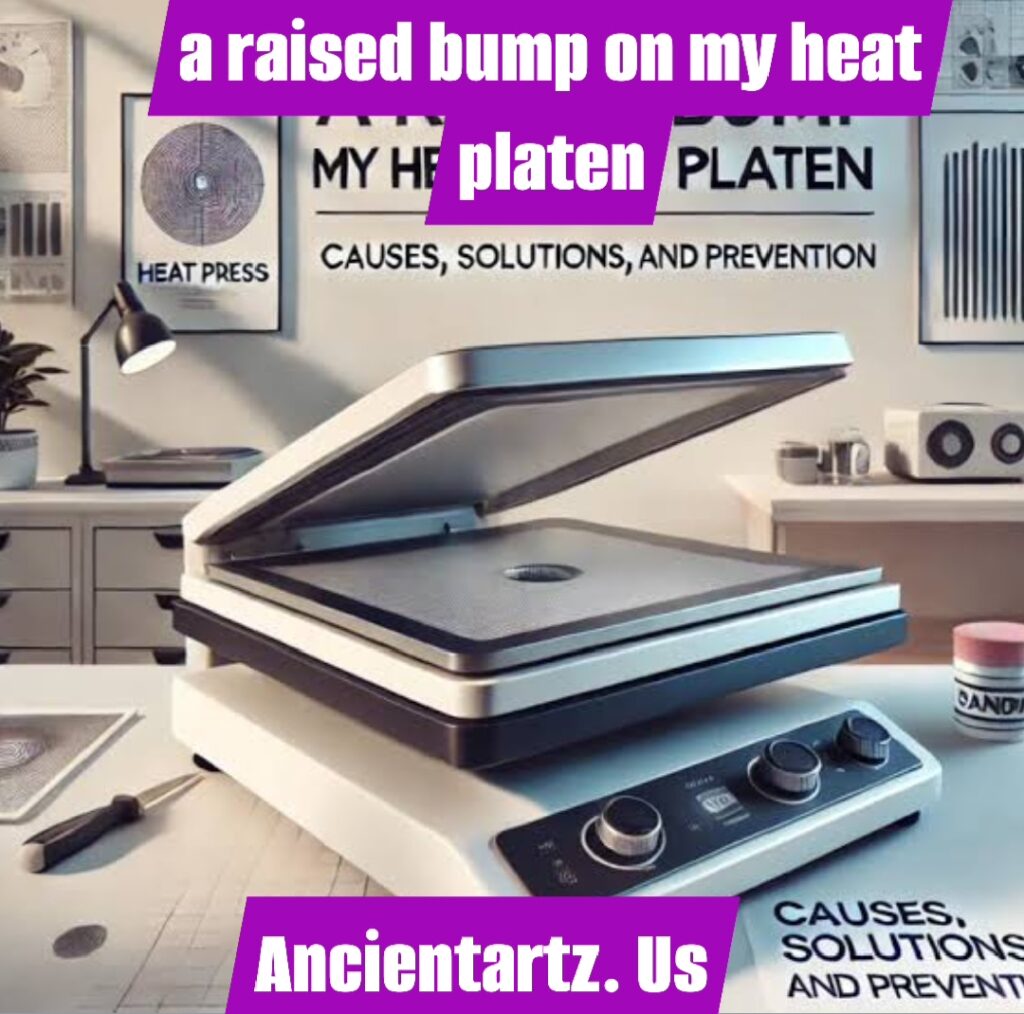Introduction
Heat platens play an integral role in the operation of heat presses, whether they are being used for creating custom apparel, sublimation printing, or other industrial processes. A smooth and even heat platen ensures consistent heat distribution, which is critical for achieving high-quality results in printing and pressing applications. However, encountering a raised bump on my heat platen can pose significant challenges. This seemingly minor issue can disrupt the production process, compromise the quality of prints, and potentially lead to equipment damage if left unaddressed. Understanding the causes, implications, and remedies of this issue is essential for any professional or hobbyist relying on a heat press.
This article delves into the specifics of identifying and managing a raised bump on my heat platen. It begins with an overview of what heat platens are and their significance in various industries. The article then explores the common causes of raised bumps, their impact on operations, and the steps to diagnose and resolve the issue. Finally, it provides preventive measures, practical advice, and answers to frequently asked questions, equipping readers with a comprehensive understanding of the topic.
Understanding Heat Platens and Their Importance
Heat platens are the heated surfaces of a heat press machine, responsible for transferring heat and pressure to a substrate, such as fabric, vinyl, or metal. They are typically made from aluminum or other heat-conductive materials and are coated with a protective layer to ensure smooth operation. These surfaces are engineered to maintain consistent temperatures across their entire area, as uniform heat distribution is key to the success of heat transfer processes.
The quality and condition of the heat platen directly influence the final product’s outcome. Even minor imperfections, such as a raised bump, can disrupt the uniformity of heat and pressure application. This can result in incomplete transfers, uneven designs, or damaged substrates. Professionals and hobbyists alike must understand how to maintain their heat platens in optimal condition to ensure the longevity of their equipment and the quality of their work.
Causes of Raised Bumps on Heat Platens
- Manufacturing Defects: One potential cause of a raised bump on a heat platen is a manufacturing defect. During production, inconsistencies in the casting or finishing processes can result in imperfections. If a defect escapes quality control, it may become apparent during use, manifesting as an uneven surface.
- Wear and Tear: Over time, frequent use of the heat press can lead to physical damage to the platen. Prolonged exposure to high temperatures and repeated pressure cycles can cause warping, dents, or raised areas on the platen surface. Regular inspection and maintenance are crucial to identifying and addressing these issues early.
- Contamination or Debris: Accumulation of residue, adhesives, or other contaminants on the platen surface can mimic the appearance of a raised bump. These materials can build up over time, especially if the platen is not cleaned regularly after use. Cleaning the platen thoroughly can often resolve this issue.
- Improper Storage or Handling: Heat presses and their components must be handled and stored with care to avoid accidental damage. Dropping or striking the machine, even lightly, can create bumps or distortions in the platen. Proper storage practices and careful handling can minimize the risk of such damage.
- Thermal Expansion Issues: Heat platens are subject to thermal expansion and contraction due to repeated heating and cooling cycles. In some cases, this can lead to surface deformities. High-quality platens are designed to resist these effects, but prolonged exposure to extreme temperatures can still cause problems.
Diagnosing the Problem
Identifying the root cause of a raised bump on my heat platen requires careful inspection and testing. Begin by examining the platen surface visually and tactilely to pinpoint the bump’s location. Use a straightedge or a level to detect uneven areas and confirm the presence of the raised bump. If necessary, utilize a thermal imaging device to check for heat distribution inconsistencies. This can help determine whether the issue is mechanical or thermal in nature.
In some cases, it may be necessary to disassemble the heat press to inspect the platen’s internal components. Consult the manufacturer’s manual for guidance, and seek professional assistance if you are unfamiliar with the process. Understanding the extent and nature of the problem is crucial for selecting an appropriate solution.
Addressing the Issue
- Cleaning the Surface: If the bump is caused by residue or debris, cleaning the platen thoroughly is the first step. Use a non-abrasive cloth and a heat press cleaner to remove any buildup. Avoid harsh chemicals or scrubbing tools that could damage the platen’s surface.
- Repairing or Replacing the Platen: For physical deformities or manufacturing defects, repair or replacement may be necessary. Minor imperfections can sometimes be sanded or polished out, but this process should be approached with caution to avoid further damage. In severe cases, replacing the platen entirely is the most effective solution.
- Seeking Professional Assistance: When in doubt, consult the manufacturer or a qualified technician. They can provide expert advice, replacement parts, or repair services tailored to your specific heat press model. Attempting complex repairs without proper expertise can exacerbate the problem.
- Upgrading Equipment: If the heat platen is outdated or prone to recurring issues, consider upgrading to a higher-quality model. Modern heat presses often feature advanced materials and designs that minimize the risk of surface deformities.
Preventive Measures
- Regular Maintenance: Clean the heat platen after every use to prevent residue buildup. Inspect the surface periodically for signs of wear or damage, and address any issues promptly to prevent them from worsening.
- Proper Storage: Store the heat press in a clean, dry environment away from heavy objects or potential hazards. Use protective covers to shield the platen from dust and debris.
- Optimal Usage Practices: Avoid applying excessive pressure or exceeding the recommended temperature settings. Follow the manufacturer’s guidelines for operation to ensure the longevity of the heat platen.
- Investing in Quality Equipment: Choose heat presses from reputable manufacturers known for their durable and reliable products. High-quality equipment is less likely to develop defects and can save time and money in the long run.
Conclusion
A raised bump on a heat platen may seem like a minor inconvenience, but it can have significant implications for the quality of your work and the lifespan of your equipment. By understanding the potential causes, diagnosing the problem accurately, and implementing effective solutions, you can restore your heat press to optimal condition. Regular maintenance and preventive measures are key to avoiding future issues and ensuring consistent, high-quality results.
Heat platens are the backbone of heat press operations, and their maintenance should not be overlooked. By taking a proactive approach to care and troubleshooting, you can protect your investment and maintain the efficiency of your production process. Whether you are a professional in the industry or an enthusiast pursuing a creative hobby, understanding the intricacies of heat platen maintenance is an invaluable skill.
Frequently Asked Questions (FAQs)
- What causes uneven heat distribution on a heat platen? Uneven heat distribution can result from a raised bump, poor-quality materials, or internal damage to the heating element. Regular inspections and maintenance can help identify and address the root cause.
- Can I fix a damaged heat platen myself? Minor issues, such as residue buildup, can be resolved with cleaning. However, significant deformities or internal damage may require professional repair or replacement.
- How often should I clean my heat platen? Clean the platen after every use to prevent residue buildup and maintain a smooth surface. Periodic deep cleaning is also recommended.
- What should I do if my heat platen develops a persistent bump? If cleaning and minor repairs do not resolve the issue, consult the manufacturer or a technician for further assistance. Replacement may be necessary in severe cases.
- Are all heat platens prone to bumps? High-quality heat platens are less likely to develop bumps due to advanced materials and construction. Investing in durable equipment can reduce the risk of such issues.
By understanding and addressing the challenges posed by a raised bump on a heat platen, you can ensure smooth operation and consistent results in your heat press applications. Equip yourself with the knowledge and tools needed to maintain your equipment, and enjoy the benefits of flawless heat transfer for years to come.
Also Read This: A Comprehensive Guide to Understanding and Addressing a Raised Bump on Your Heat Platen



